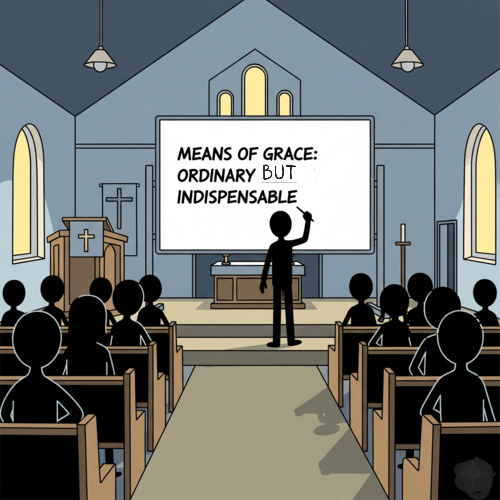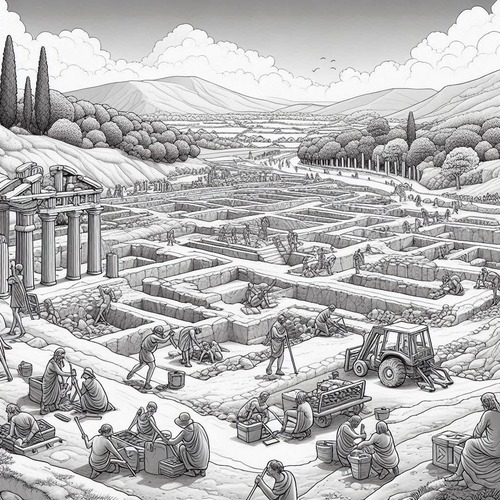Do Textual Variants Undermine Bible Reliability?
Do Textual Variants Undermine Bible Reliability? The discovery of varying readings among Bible manuscripts has led some to question Scripture’s reliability. However, when properly understood, these textual variants actually strengthen our confidence in the Bible’s faithful transmission. Far from undermining biblical authority, the field of textual criticism demonstrates God’s providential preservation of His Word through the centuries.
UNDERSTANDING TEXTUAL VARIANTS: THE BASICS
Textual variants are differences between manuscript copies. These variations emerged as scribes hand-copied manuscripts over centuries. Most variants fall into simple categories:
- Spelling differences and obvious scribal errors: For instance, in 1 Thessalonians 2:7, some Greek manuscripts spell a word as ‘infants’ while others have ‘gentle’—a difference of a single letter. Another example is the various spellings of David throughout the New Testament.
- Word order variations that don’t affect meaning: In John 1:30, some manuscripts read ‘whom I said’ while others have ‘whom said I’. Both convey identical meaning in Greek, just as “I said” and “said I” mean the same in English.
- Substitution of synonymous words: In Matthew 9:18, some manuscripts read ‘ruler’ or ‘one ruler’—all conveying essentially the same meaning. Another example is the interchangeable use of “Christ Jesus” and “Jesus Christ” in some manuscripts.
- Occasional additions or omissions of words: In Acts 9:6, some manuscripts include “trembling and astonished,” while others omit these words. Similarly, some manuscripts add “and fasting” to Mark 9:29, though the meaning of the passage remains clear in both cases.
While the total number of variants may seem large at first glance, this is primarily because we have an abundance of manuscripts. More manuscripts naturally mean more minor variations, but they also provide scholars with better tools for determining the original text.
THE MANUSCRIPT EVIDENCE
The New Testament’s manuscript evidence far exceeds any other ancient text. We possess over 5,800 Greek manuscripts, more than 10,000 Latin manuscripts, thousands of manuscripts in other early languages, some fragments dating to within decades of original composition, and manuscripts found across a vast geographic range.
Compare this to other ancient works: Caesar’s Gallic Wars survives in only 10 manuscripts, with the earliest copy dating 1,000 years after composition. Tacitus’ Annals has only two manuscripts. The overwhelming number of biblical manuscripts allows scholars to cross-reference and verify readings with remarkable accuracy.
COMMON MISCONCEPTIONS ABOUT TEXTUAL VARIANTS
Critics often compare Bible transmission to the children’s telephone game, where a message becomes garbled as it passes from person to person in a single line, resulting in a completely different message by the end. However, this analogy fundamentally misunderstands how Bible manuscripts were transmitted.
Availability of multiple source manuscripts: Unlike the telephone game’s single chain of transmission, ancient scribes typically worked with multiple source manuscripts spread out before them, comparing readings and cross-referencing texts.
The earliest biblical manuscripts didn’t disappear after being copied but continued to circulate and be used for centuries. The famous Codex Vaticanus from the 4th century, for instance, remains preserved today and was actively used as a reference text for over a millennium.
Rigorous scribal practices: Professional scribal communities, especially in monasteries and scholarly centres, maintained rigorous standards for copying. In Jewish traditions, scribes would count letters and words in each line, and an entire manuscript would be destroyed if significant errors were found. Christian scribes similarly developed detailed systems of cross-checking and verification.
When variations appeared in manuscript copies, they could be checked against manuscripts from other regions. For example, a reading found in manuscripts from both Syria and North Africa was likely to be original, as these communities had little contact and wouldn’t share the same copying errors. Moreover, variants don’t multiply with each generation of copying. Instead, comparison between manuscript families helps identify and eliminate copying mistakes.
SIGNIFICANT VARIANTS IN CONTEXT
While the number of variants is large, their significance must be properly understood:
- Over 99% of variants are minor and don’t affect meaning: Of the approximately 400,000 textual variants identified, over 99% involve differences in spelling, word order, or minor grammatical points that don’t affect translation – such as whether to write “Jesus Christ” or “Christ Jesus,” or whether to include or omit the definite article “the” in Greek phrases.
- No essential Christian doctrine depends on disputed texts: Not a single cardinal doctrine of the Christian faith depends solely on a disputed text. The deity of Christ, for instance, is taught in numerous undisputed passages like John 1:1-14, Colossians 1:15-20, and Hebrews 1:1-4, while the resurrection is attested in multiple undisputed passages across all four Gospels and Paul’s letters.
- Most variations are easily resolved through manuscript comparison: The vast majority of variations can be resolved by comparing multiple manuscript families and applying standard text-critical principles. For example, scholars can typically identify original readings by examining which variant appears in the earliest and most widely distributed manuscripts.
- Major variants are well-documented in Bible translations: Even the most famous textual variants, such as the longer ending of Mark (16:9-20) and the story of the woman caught in adultery (John 7:53-8:11), are clearly marked in modern translations with notes explaining their manuscript evidence. This ensures full transparency for readers.
GOD’S PROVIDENCE IN PRESERVATION
The Reformed doctrine of Scripture emphasises God’s providential preservation of His Word. This doesn’t require perfect transmission of every letter, but rather the faithful preservation of the text’s meaning and message. The Westminster Confession affirms the Scriptures have been “kept pure in all ages” by God’s singular care and providence.
CONCLUSION: DO TEXTUAL VARIANTS UNDERMINE BIBLE RELIABILITY?
The study of textual variants, far from undermining the Bible’s reliability, demonstrates the remarkable preservation of Scripture. The vast manuscript evidence, careful scribal transmission, and modern scholarly tools all confirm we can trust the Bible we have today. While textual variants exist, they serve to strengthen rather than weaken our confidence in God’s Word.
DO TEXTUAL VARIANTS UNDERMINE BIBLE RELIABILITY?—RELATED FAQs
If 99% of variants don’t affect meaning, what about the remaining 1%? The most well-known meaningful variants include the longer ending of Mark (16:9-20), the story of the woman caught in adultery (John 7:53-8:11), the Johannine Comma (1 John 5:7-8 in KJV), and variants in passages like Luke 23:34 (“Father, forgive them”) and John 1:18 (whether it reads “the only begotten God” or “the only begotten Son”). Some other examples include the explicit mention of Jesus’ anger in Mark 1:41 in some manuscripts, the doxology of the Lord’s Prayer in Matthew 6:13, and variant readings about fasting in Mark 9:29 and Acts 8:37.
However, it’s crucial to understand that even these more substantial variants don’t undermine any core Christian doctrine or biblical teaching. Each disputed text has parallel teachings elsewhere in undisputed passages of Scripture. For instance, while the longer ending of Mark has textual questions, the resurrection appearances it describes are attested in other Gospels. Similarly, while the Johannine Comma’s trinitarian formula is debated, the doctrine of the Trinity is clearly taught throughout Scripture. These variants demonstrate the transparency of biblical scholarship and actually reinforce our confidence that we can identify both the original text and later additions through careful textual criticism. (CHECK OUT OUR POST:
- How can we trust the Bible with so many textual variants? The large number of variants actually demonstrates the rich manuscript tradition we possess. With over 5,800 Greek manuscripts, we can compare readings across different times and regions to identify the original text with remarkable accuracy. This abundance of manuscripts allows scholars to cross-reference and verify readings, making the Bible the most reliably transmitted ancient text.
- What about Bart Ehrman’s claims that the Bible has been corrupted? Ehrman’s popular works often overstate the significance of textual variants and their impact on the biblical message. While he correctly identifies the presence of variants, he rarely acknowledges that the vast majority (over 99%) don’t affect meaning. No essential Christian doctrine depends on disputed passages. The manuscript evidence actually demonstrates remarkable consistency in transmission.
How do textual variants compare to other ancient documents? The New Testament has exponentially more manuscript evidence than any other ancient text. While Caesar’s Gallic Wars has only 10 manuscripts with a 1,000-year gap from composition, we have thousands of biblical manuscripts, some dating within decades of the originals. This overwhelming evidence makes the Bible the most well-documented ancient text by far.
- What does my Bible’s footnote about “some manuscripts” mean? These footnotes represent scholarly transparency about textual variants in the manuscript tradition. Modern translations include these notes to inform readers when there are meaningful differences between manuscripts. This practice demonstrates the academic rigour behind Bible translation and should increase our confidence in its reliability.
- Do Muslims have a point when they say the Bible has been corrupted? Islamic claims about biblical corruption ignore the vast manuscript evidence and misunderstand the nature of textual transmission. While the Quran’s textual history involves the destruction of variant manuscripts under Uthman, biblical manuscripts were preserved across different regions and languages, allowing for careful comparison and verification of readings.
How should I understand significant variants like the ending of Mark? Major variants like Mark 16:9-20 and John 7:53-8:11 are well-documented in modern translations with clear notes about their manuscript evidence. These passages, while historically valued by the church, don’t affect any core Christian doctrine. Their transparent treatment in modern Bibles demonstrates the careful scholarship behind biblical transmission.
- What role do Dead Sea Scrolls play in proving Bible reliability? The Dead Sea Scrolls provide remarkable evidence for the Old Testament’s faithful transmission, showing minimal changes over a thousand years of copying. When comparing the Isaiah scroll from Qumran with medieval manuscripts, we find 95% word-for-word agreement, with the 5% variation consisting mainly of obvious spelling and grammatical differences.
- How do scholars determine which variant reading is original? Scholars use well-established principles of textual criticism, including examining the age of manuscripts, geographical distribution of readings, and the likelihood of scribal changes. They consider which reading best explains the origin of others and which fits the author’s style and context. Multiple lines of evidence typically point to the original reading.
Can I trust my English Bible translation? Modern Bible translations are based on excellent manuscript evidence and careful scholarly work. Translation teams include experts in textual criticism who evaluate variant readings and make well-informed decisions. Major translations also provide footnotes about significant variants, ensuring transparency about the underlying texts.
DO TEXTUAL VARIANTS UNDERMINE BIBLE RELIABILITY?—OUR RELATED POSTS
Editor's Pick

Should We Stop Using Male Pronouns for God? Why Do We Say No?
A friend of ours arrived eagerly at his first theology class in seminary. But he quickly discovered something troubling: the [...]

Did Old Testament Law Force Women to Marry their Rapists?
**Editor’s Note: This post is part of our series, ‘Satan’s Lies: Common Deceptions in the Church Today’… Viral misinformation abounds [...]

From Danvers To Nashville: Two Statements, One Biblical Vision
30 years separate the Danvers Statement on Biblical Manhood and Womanhood (1987) and the Nashville Statement on Human Sexuality (2017). [...]

The Nashville Statement: Why Affirm It Despite Media Backlash?
WHY DO REFORMED CHRISTIANS STAND BY THIS STATEMENT ON MARRIAGE AND GENDER? When the Nashville Statement was released in 2017, [...]

Who Is Belial? Solving The 2 Corinthians 6:15 Mystery
Belial: This name from the pages of Scripture chills the soul. Who is this mysterious figure Paul invokes in 2 [...]

Celibacy Or Castration: What Jesus Really Means in Matthew 19:12
One of Scripture's most shocking misinterpretations led theologian Origen to castrate himself in the third century. His tragic mistake? Taking [...]

Philippians 4:13: Did Paul Really Mean We Can Do ALL Things?
"I can do all things through Christ who strengthens me." It's on gym walls, graduation cards, and motivational posters everywhere. [...]

The Ordinary Means of Grace: Why Are They Indispensable?
ORDINARY MEANS FOR EXTRAORDINARY TRANSFORMATION What if God's most powerful work in believers' lives happens through the most ordinary activities? [...]

Is the Bible God’s Word? Or Does It Only Contain God’s Word?
The authority of Scripture stands at the crossroads of modern Christianity. While some argue the Bible merely contains God’s Word [...]

Will We Remember This Life in Heaven? What Isaiah 65:17 Means
"Will I remember my spouse in heaven? My children? Will the joy we shared on earth matter in eternity?" These [...]
SUPPORT US:
Feel the Holy Spirit's gentle nudge to partner with us?
Donate Online:
Account Name: TRUTHS TO DIE FOR FOUNDATION
Account Number: 10243565459
Bank IFSC: IDFB0043391
Bank Name: IDFC FIRST BANK






